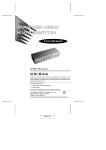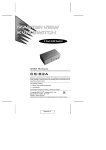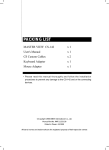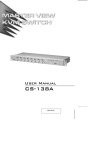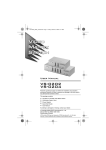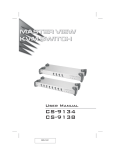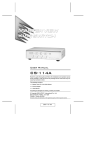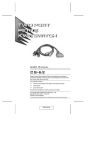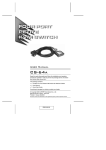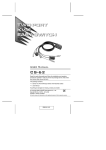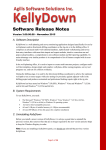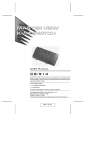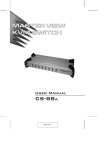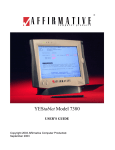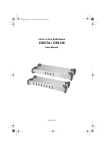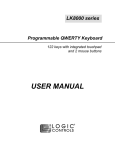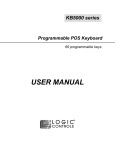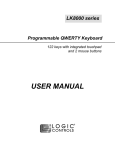Download Corel Ventura
Transcript
User Manual CS-124A Read this guide thoroughly and follow the installation and operation procedures carefully in order to prevent any damage to the units and/or any devices that connect to them. This package contains: M 1 Master View CS-124A KVM Switch M 1 Power Adapter M 1 User Manual If anything is damaged or missing, contact your dealer. © Copyright 2000 ATEN International Co., Ltd. Manual Part No. PAPE - 1156-300 Printed in Taiwan 03/2001 All brand names and trademarks are the registered property of their respective owners. 2001-03-09 Overview The Master View CS-124A 4 Port KVM (Keyboard, Video, Mouse), Switch is a control unit that allows access to four computer systems from a single PS/2 keyboard, PS/2 mouse, and monitor console in a cost effective manner. There are three convenient methods to access the computers: (1) push button port selection switches; (2) Hotkey combinations; and (3) a Foot Switch (optional). Setup is fast and easy; simply plug cables into their appropriate ports. There is no software to configure, no installation routines, and no incompatibility problems. Since the CS-124A intercepts keyboard input directly, it works on any hardware platform and with all operating systems. There is no better way to save time and money than with a Master View CS-124A installation. Since a single console manages all of the computers, the CS-124A setup: eliminates the expense of having to purchase a separate keyboard, monitor, and mouse for each computer; saves all the space those extra components would take up; saves on energy costs; and eliminates the inconvenience and wasted effort involved in constantly moving around from one computer to another. Features M Supports MS Intellimouse (3 keys) M Mouse Conversion: One PS/2 Mouse Controls All Connected Computers - Those That Use PS/2 Mice As Well As Those That Use Serial Mice M Superior Video Quality; 1920x1440; DDC; DDC2; DDC2B M Hot Pluggable: Computers Can Be Added or Removed for Maintenance Without Powering Down the CS-124A M Easy to Operate - Computer Selection Via Push Button Switches, HotKeys, or Optional Foot Switch M Caps Lock, Num Lock, and Scroll Lock, States are Saved and Restored When Switching M Auto Scan Function Automatically Switches Through the Powered Up Computers to Monitor Computer Operation M Last/Next Function Allows Users to Skip to the Previous or Next Computer on the Installation Without Leaving the Keyboard M On Line and Status LEDs for Easy Status Monitoring M Cascadable to Three Levels - Control Up To 64 Computers M Easy to Install - No Software Required - Standard Cables to Connect to the Computers Is All It Takes M Saves Time, Space, Power, and Equipment Costs M Rack Mountable (With Optional Rack Panel - Part No. 2X-004) -1- 2001-03-09 Hardware Requirements Console M A VGA, SVGA, or Multisync monitor capable of the highest resolution that you will be using on any PC in the installation M A PS/2 Style Mouse M A PS/2 Style Keyboard Computers The following equipment must be installed on each PC that is to be connected to the system: M A VGA, SVGA or Multisync card. M Either a 6-pin mini-DIN (PS/2 style), or DB-9 (standard serial), mouse port. M Either a 6-pin mini-DIN (PS/2 Style) keyboard port with +5V DC on pin 4 and Ground on pin 3, or a 5-pin DIN (AT Style) keyboard port with +5V DC on pin 5 and ground on pin 4.* * See the note under Cables in the next section. Cables Use of substandard cables may damage the connected devices or degrade overall performance. For optimum signal integrity and to simplify the layout, we strongly recommend that you use the following ATEN high quality CS Custom Cable sets: 2L-1001P/C (1.8 m) and 2L-1003P/C (3 m). Note: 1. If your computer uses a standard AT style keyboard socket you will need to purchase a PS/2-to-AT keyboard adapter (Part No. 2A-106, or any standard keyboard adapter). 2. If your computer uses a 9 pin serial port, you will need a special PS/2-to-Serial mouse adapter (Part No. 2A-105); a standard mouse adapter will probably not work. -2- 2001-03-09 Introduction Front View 3 1 2 1. On Line and Selected LEDs: M When an On Line LED is lit, it indicates that the computer attached to the corresponding port is up and running. M When a Selected LED is lit, it indicates that the port it corresponds to is the currently selected port. Depending on the port’s status, the LED may flash according to a specific pattern (see the LED Display table in the Appendix for details). 2. Port Selection Switches M Press a switch to access the PC attached to the corresponding port. M K/M Reset: If the keyboard and mouse get stuck and need to be reset, simultaneously press this Port1 / Port2 switch combination for three seconds. 3. Auto Scan Switch M Press this switch to activate Auto Scanning. To stop, press it again, or press the keyboard’s Spacebar. M Auto Scan Mode can also be invoked by simultaneously pressing the Port3 / Port4 switch combination for five seconds. M The amount of time it dwells on each port is determined with segments 1 and 2 of the Master View CS-124A’s DIP Switch (located at the left of the rear panel). See the table in the Appendix for setting details. -3- 2001-03-09 Rear View 1 2 3 4 5 1. Power Jack The CS-124A is designed to be non-powered (external power is not required - its operation power comes from the computers). In general, the only time that external power is required is when you daisy chain it, or if operation becomes erratic because the unit isn’t obtaining enough power from the computer connections. If you choose to use external power, the power adapter cable plugs in here. 2. DIP Switch Switches 1 and 2 select the Scan Time; Switch 3 selects the Hotkey Combination; Switch 4 selects the operation type for Last/Next Mode. See DIP Switch Settings in the Appendix for details. 3. Console Port Section M If this is a first station unit, your monitor, keyboard and mouse plug in here. M If this is a daisy chained unit, the cables that link back to a port on a higher Master View unit plug in here. 4. CPU Port Section The extender cables that connect the unit’s monitor, keyboard and mouse ports to the computer’s monitor, keyboard and mouse ports plug in here. 5. Optional Foot Switch Connector If you are using an optional foot switch, its cable plugs in here. -4- 2001-03-09 Installation Before You Begin Single Stage Installation To prevent damage to your installation due to ground potential difference, make sure that all devices on the installation are properly grounded. The most basic installation is a Single Stage installation, in which no additional Master View’s are daisy chained down from the first unit. The Master View CS-124A design also allows additional units to be daisy chained down to two or three levels. To set up a single stage installation do the following: 1. Make sure that power to all the devices you will be connecting up have been turned off. You must unplug the power cords of any computers that have the Keyboard Power On function. Otherwise, the switch will receive power from the computer. 2. Plug the monitor, keyboard, and mouse into the Console port connectors (located to the left of the CPU ports) of the Master View CS-124A unit. Each port is labeled with an appropriate icon to indicate itself. 3. Use extender cables (see the Hardware Requirements section), to connect the keyboard, monitor, and mouse ports from any available CPU Port (1 - 4), to the keyboard, monitor, and mouse ports of the computers you are connecting up (see the diagram on p. 7). 4. If you choose to use an optional foot switch, plug its cable into the Footswitch connector. 5. If you choose to use external power, plug the power adapter into an AC source, then plug the cable into the CS-124A’s Power Jack. 6. Turn on the power to the connected computers. Under non-powered operation, the unit gets its power from the computers via the keyboard and mouse cables. If a computer only supplies 3.3V of power for the keyboard and mouse instead of 5V (as in the case of Notebooks, for example), the unit will not receive enough power, and you will need to use the external power adapter. -5- 2001-03-09 Two Stage Installation To control even more computers, up to four additional Master View CS-124A units can be cascaded from the CPU ports of the First Stage unit. The cascaded Master Views that connect back to the First Stage unit are considered Second Stage units. As many as 16 computers can be controlled in a complete two stage installation. Note: Mixing different Master View models on the same daisy chain can cause problems with Hotkey port switching. We strongly recommend that you use CS-124As for all the cascaded units. To set up a two stage installation, do the following: 1. Make sure that power to all the devices you will be connecting up, including all preexisting devices on the installation, have been turned off. You must unplug the power cords of any computers that have the Keyboard Power On function. Otherwise, the switch will receive power from the computer. To prevent damage to your installation due to ground potential difference, make sure that all devices on the installation are properly grounded. 2. For the First Stage unit, plug the power adapter that came with it into an AC power source, then plug the adapter cable into the its Power Jack. 3. Use connector cable sets (see the Hardware Requirements section), to connect the ports from any available CPU Port (1 - 4) on the First Stage unit to the Console Port connectors of the Second Stage CS-124A. 4. If you choose to use an optional foot switch, plug its cable into the Footswitch connector. 5. Plug the power adapter that came with the unit into an AC power source, then plug the adapter cable into the CS-124A’s Power Jack. 6. Repeat steps 3 - 5 for any other Second Stage Master View CS-124A units you wish to connect. 7. Use connector cable sets to connect the keyboard, monitor, and mouse ports from any available CPU Port to the keyboard, monitor, and mouse ports of the computers you are connecting up (see the diagram on p. 7). 8. Turn on the power to all the connected computers. -6- 2001-03-09 Three Stage Installation The procedures for setting up a three stage installation are essentially the same as for a two stage installation. With a three stage setup, however, as many as 64 computers can be controlled in a complete installation. Note: Master View units cannot be cascaded beyond the third level. -7- 2001-03-09 Operation Powering Off and Restarting If it becomes necessary to Power Off one of the Master View units, before starting it back up you must do the following: 1. Shut down all the computers that are attached to it. If the unit is operating under external power, unplug the power adapter cable. Do the same for all the stations and all the computers that are daisy chained down from it (all the child stations and the computers attached to them). Note: 1. If any of the computers have the Keyboard ’Power On’ function, you must unplug their power cords, otherwise the switch will still receive power from the PC which will cause problems when you bring the installation back up. 2. It is not necessary to shut down and restart any of the stations or computers above the station you powered off. 2. Wait 10 seconds. a) For CS-124As operating under external power, plug the power adapter cables back in, starting with the last station in the chain and working back to the station you originally shut down. b) After the externally powered units are up, turn the computers back on starting with the ones attached to the last station in the chain and working back to the station you originally shut down. Port Selection Manual Port Selection Manual port selection is accomplished either with the Port Selection switches on the front panel of the Master View CS-124A unit, or with an optional foot switch. M Port Selection Switches: Press the Port Selection switch of the unit that corresponds to the computer that you want to access. On a daisy chained installation, you must press the Port Selection switch on the Master View Station that connects directly to the computer you want to access. M Foot Switch: Each time you step on the foot switch the active focus switches from the current computer to the next one down on the installation. After the last computer you cycle back to the first and start over. -8- 2001-03-09 Hotkey Port Selection Hotkey Port Selection allows you to select the active computer directly from the keyboard. The Master View CS-124A provides the following Hotkey Port Selection features: M Selecting the Active Port M Auto Scan Mode M Last/Next Mode Hotkey Port Selection is activated with one of two combinations: M The default combination is [Alt+Ctrl+Shift]. If you use this method, the combination must all be on the same side (i.e., LeftAlt+LeftCtrl+LeftShift or RightAlt+RightCtrl+RightShift). M The alternate combination is pressing and releasing both Ctrl keys simultaneously ([Left Ctrl+Right Ctrl]). If this conflicts with programs running on the computers, the default combination must be used. The activation combination is chosen with DIP Switch 3 on the rear panel of the First Stage unit. Set the switch to ON for Alt+Ctrl+Shift (Hot Key 1); set it to OFF for LCtrl+RCtrl (Hot Key 2). M Selecting the Active Port: Since each CPU port is assigned a unique Port ID, you can directly access any computer on any level of the installation using a Hotkey combination that specifies the Port ID of the CPU Port that the computer is connected to. The steps involved are: 1. Press and simultaneously release the Hotkey activation combination (Alt+Ctrl+Shift or LCtrl+RCtrl) 2. Key in the appropriate Port ID one digit at a time (see note below). 3. Press [Enter] to complete your selection. Note: The Port ID is a one, two, or three digit number that is determined by the Stage Level and CPU Port number of the Master View unit that the computer is connected to. The first digit represents the CPU Port number of the First Stage unit; the second digit represents the CPU Port number of the Second Stage; the third digit represents the CPU Port number of the Third Stage. For example, to access a computer attached to a First Stage unit, simply key in a one digit number (1 - 4), that corresponds to the CPU Port number that the computer is connected to. -9- 2001-03-09 To access a computer attached to a Second Stage unit, key in a two digit number for the Port ID (press and release each number separately). The first digit represents the CPU Port number (1 - 4), on the First Stage unit that the Second Stage unit is cascaded down from; the second digit represents the CPU Port number on the Second Stage unit that the computer is connected to. Likewise, to access a computer attached to a Third Stage unit, key in a three digit number following the method described for the Second Stage unit. Some examples are given in the table below: This Combination Does the Following [Alt + Ctrl+ Shift] 1 [Enter] 0r [LCtrl + RCtrl] 1 [Enter] Selects the computer connected to Port 1 on the First Stage unit. [Alt + Ctrl+ Shift] 1 2 [Enter] 0r [LCtrl + RCtrl] 1 2 [Enter] Selects the computer connected to Port 2 on a Second Stage unit, connected back to Port 1 on the First Stage unit. [Alt + Ctrl+ Shift] 4 2 3 [Enter] 0r [LCtrl + RCtrl] 4 2 3 [Enter] Selects the computer connected to Port 3 on a Third Stage unit, connected back to Port 2 on a Second Stage unit, connected back to Port 4 on the First Stage unit. M Auto Scan Mode: Auto Scan automatically switches among all the active CPU Ports of all the Master View units in the installation at regular intervals, so that you can monitor their activity automatically. The amount of time it dwells on each port is determined with segments 1 and 2 of the First Stage unit’s DIP Switch (see the Scan Time table in the Appendix for setting details. To invoke Auto Scan Mode, key in the following Hotkey combination: 1. Press and simultaneously release the Hotkey activation combination ([Alt+Ctrl+Shift] or [LCtrl+RCtrl]) 2. Press 0 (zero) 3. Press [Enter] To exit Auto Scan Mode, press the [Spacebar]. The port that is currently active at the time scanning stops remains active. Note: While Auto Scan Mode is in effect, the console will not function. You must exit Auto Scan Mode in order to regain control of the console. - 10 - 2001-03-09 M Last/Next Mode: Last/Next mode enables you to easily switch from the currently active computer to the previous or next available computer in the installation. There are two methods of invoking Last/Next Mode: Quick Mode, and Basic Mode. The choice of mode is made with DIP Switch 4. Set the switch to ON to enable Quick Mode; Set the switch to OFF for Basic Mode. Quick Mode: With Quick Mode enabled Last/Next selection is always immediately available - it does not have to first be invoked with [Alt+Ctrl+Shift] as the Basic method does. At any time: M Press [LCtrl] + [LCtrl] to switch from the currently active computer to the one previous to it; or M Press [RCtrl] + [RCtrl] to switch from the currently active computer to the next one in the installation. Besides being more convenient for switching than Basic Mode, another advantage of this method is that the keyboard remains active so you can use the console to carry out commands on the accessed computer. The disadvantage is that pressing the Ctrl keys may conflict with programs already running on the computers. Basic Mode: With Basic Mode, you must first invoke the function before you can switch. To invoke Basic Mode: 1. Press and simultaneously release [Alt+Ctrl+Shift] or [LCtrl+RCtrl] 2. Press 9 3. Press [Enter] Once Basic Mode has been invoked: M Press the left Shift key (LShift) to switch from the currently active computer to the one previous to it; M Press RShift to switch from the currently active computer to the next one in the installation. Note: With this method, while Last/Next Mode is in effect, the console will not function. You must exit Last/Next Mode by pressing the [Spacebar] in order to regain control of the console. - 11 - 2001-03-09 Appendix DIP Switch Settings Note: The default position for all settings is ON. M Switches 1 & 2 - Scan Time: Seconds Switch 1 5 On On 10 Off On 20 On Off 40 Off Off M Switch 3 - Hotkey Select: ON: Default - [Alt+Ctrl+Shift] OFF: Alternate - [Left Ctrl+Right Ctrl] M Switch 4 - Last/Next Mode Select: ON: Quick Last/Next Mode OFF: Basic Last/Next Mode Switch 2 Hotkey Summary Table Activity DIP Switch Combination Port Select (Hotkey Method 1) 3 On [Alt+Ctrl+Shift] Port ID [Enter] Port Select (Hotkey Method 2) 3 Off [LCtrl+RCtrl] Port ID [Enter] Auto Scan (Hotkey Method 1) 3 On [Alt+Ctrl+Shift] 0 [Enter] Auto Scan (Hotkey Method 2) 3 Off [LCtrl+RCtrl] 0 [Enter] Quick Last/Next Mode 4 On [LCtrl+LCtrl] - Last [RCtrl+RCtrl] - Next Basic Last/Next Mode (Hotkey Method 1) 3 On / 4 Off [Alt+Ctrl+Shift] 9 [Enter]; Basic Last/Next Mode (Hotkey Method 2) 3 Off / 4 Off [LCtrl+RCtrl]; LShift - Last; RShift - Next LShift - Last; RShift - Next - 12 - 2001-03-09 Selected LED Display Activity Meaning Off Port is not selected. On (Steady) Port is connected to an active PC. Flashing (On short; Off long) Port is connected to a lower stage Master View CS124A. Flashing (On and Off equal) Port is connected to an active PC and is being accessed in Auto Scan mode. Flashing (On long; Off short) Port is connected to an active PC and is being accessed in Last/Next mode. Specifications Function Power Consumption PC Connections Direct 4 Max 64 (Via Daisy Chain) Port Selection LEDs Connectors Conversion Specification 800 mW Push Button Switches; Hot Keys; Foot Switch (Optional) On Line 4 Orange Selected 4 Green Keyboard 1 x 6 pin mini-DIN female (PS/2 style) - Console 4 x 6 pin mini-DIN female (PS/2 style) - CPU Ports Mouse 1 x 6 pin mini-DIN female (PS/2 style) - Console 4 x 6 pin mini-DIN female (PS/2 style) - CPU Ports Video 1 x HDB-15 female (std. VGA/SVGA) - Console 4 x HDB-15 male (std. VGA/SVGA) - CPU Ports Keyboard PS/2 and PC/AT Mouse PS/2 and Serial Scan Interval 5, 10, 20, 40 Seconds Resolution 1920 x 1440; DDC, DDC2, DDC2B Housing Metal Weight 1200 g Dimensions (L x W x H) 224 x 152 x 52 mm - 13 - 2001-03-09 Troubleshooting Symptom Possible Cause Action Erratic Behavior Unit not receiving enough power under self-powered operation. Use the Power Adapter that was supplied with the unit to provide external power. Keyboard Not Responding1 Loose cables. Check all keyboard cable connections to make sure they are completely seated in their sockets. Keyboard needs to be reset. Unplug the keyboard from the Console Keyboard Port, then plug it back in. Master View is in Auto Scan or Last/Next Mode. Press the [Spacebar] to exit Auto Scan or Last/Next Mode. Selected port connects to a powered Off computer. Manually change to a connected port by pressing an appropriate Port Selection switch. Pressing Hot Keys Gets No Response. Mouse Not Detected, or Does Not Respond Correctly2 Resend the Hotkey command selecting a port that has a powered On computer attached. Hotkey sequence input incorrectly. Resend the Hotkey command - press and release each key in the sequence individually. Master View is in Auto Scan or Last/Next Mode. Press the [Spacebar] to exit Auto Scan or Last/Next Mode. Loose cables. Check all mouse cable connections to make sure they are completely seated in their sockets. Use of a Standard Serial Extender Cable with Mouse Port Adapters at Both Ends Because of the wiring and pin assignments, you cannot use a Serial-to-PS/2 adapter at the end that plugs into the CS-124A. Use a PS/2 extender cable with a mouse adapter on the end that plugs into the computer. Mouse needs to be reset. Unplug the mouse from the Console Keyboard Port, then plug it back in. Master View needs to be reset. Turn off the PCs and the Master Views. Wait five seconds; turn the Master View unit on; then turn the PCs on. Make sure to follow the Powering Off and Restarting sequence as described in the Operation section. Mouse set to Serial Mode. Some mice can be set to act as either a PS/2 or serial mouse. Make sure the mouse is set to PS/2 mode. Incorrect Mouse Driver. Check your Device Manager to be sure that the correct driver for your mouse (obtained from the manufacturer, or supplied by the operating system), has been installed. Because of the wide variety of mouse driver standards for the modern series of mice (the ones with the extra buttons and wheels), this unit only supports all of the extra features of the Microsoft Intellimouse. It supports the scroll wheel function of most other mice. - 14 - 2001-03-09 Video Problems Resolution and/or Bandwidth set too high. This unit supports VGA, SVGA, Multisync, and XGA (interlaced), with resolutions of up to 1920x1440. The maximum bandwidth is 180 MHz. Cable quality not good enough. We strongly recommend that you use high quality cables 1 The unit is designed to work with AT and PS/2 keyboards. Older XT (84 key) and some older AT keyboards (those with the function keys on the side), will not work. 2 Some Notebooks, notably the IBM Thinkpad and Toshiba Tecra, have trouble when their mouse and keyboard ports are used simultaneously. To avoid this, only connect the mouse port or the keyboard port. If you connect the mouse port, you will need to use the notebook’s keyboard when the notebook becomes the active computer. Radio & TV Interference Statement WARNING!!! This equipment generates, uses and can radiate radio frequency energy and, if not installed and used in accordance with the instruction manual, may cause interference to radio communications. This equipment has been tested and found to comply with the limits for a Class B computing device pursuant to Subpart J of Part 15 of FCC Rules, which are designed to provide reasonable protection against such interference when operated in a commercial environment. Operation of this equipment in a residential area is likely to cause interference, in which case the user at his own expense will be required to take whatever measures may be required to correct the interference. Limited Warranty IN NO EVENT SHALL THE DIRECT VENDOR’S LIABILITY EXCEED THE PRICE PAID FOR THE PRODUCT FROM THE DIRECT, INDIRECT, SPECIAL, INCIDENTAL OR CONSEQUENTIAL DAMAGES RESULTING FROM THE USE OF THE PRODUCT, DISK OR ITS DOCUMENTATION. The direct vendor makes no warranty or representation, expressed, implied, or statutory with respect to the contents or use of this documentation, and specially disclaims its quality, performance, merchantability, or fitness for any particular purpose. The direct vendor also reserves the right to revise or update the device or documentation without obligation to notify any individual or entity of such revisions, or update. For further inquires please contact your direct vendor. - 15 - 2001-03-09
















